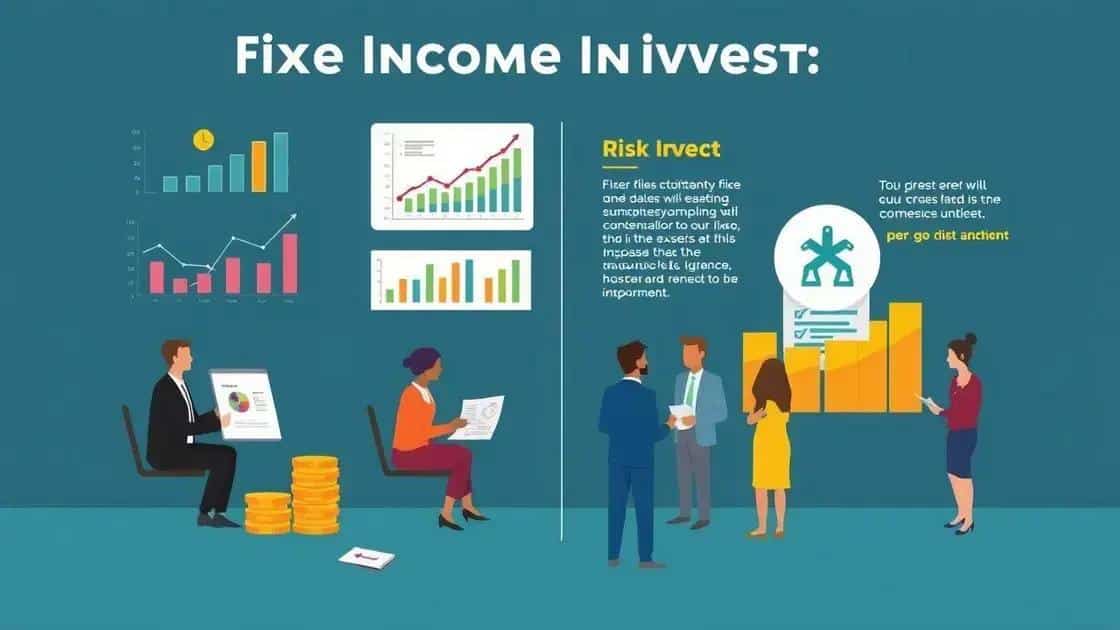Insights on fixed-income investment trends for your portfolio

Fixed-income investing provides steady income through bonds and similar securities, offering capital preservation and lower volatility while necessitating awareness of risks like interest rate and credit risk.
Insights on fixed-income investment trends can significantly enhance your financial decision-making. As market dynamics evolve, knowing how these trends impact your choices is crucial. What can you do to ensure your investments yield the best returns?
Understanding fixed-income investments
Understanding fixed-income investments is essential for anyone looking to build a stable financial portfolio. These investments can offer predictable returns and reduce overall risk. Let’s explore what makes them unique.
What are fixed-income investments?
Fixed-income investments are securities that provide regular income through interest payments. They include bonds, treasury bills, and municipal bonds. Unlike stocks, they typically do not fluctuate wildly in price. This makes them appealing to many investors.
Key features of fixed-income investments
Here are some crucial characteristics that define fixed-income securities:
- Regular interest payments.
- Principal repayment at maturity.
- Lower risk compared to stocks.
- Variety of types catering to different investors.
When you invest in fixed-income securities, you essentially lend your money to an entity, such as a government or corporation, which in return promises to pay you back with interest. This mechanism attracts many because of the reliability it offers.
Moreover, fixed-income investments can also serve as a hedge against volatility. They often perform better in turbulent markets, providing a cushion when stock values plunge. Understanding the types available allows investors to tailor their portfolios effectively.
- Government bonds – considered very safe.
- Corporate bonds – offer higher returns with more risk.
- Municipal bonds – tax-free advantages for certain investors.
Investors appreciate that fixed-income securities can offer a balance between risk and return. As you delve deeper, consider how they fit into your overall investment strategy.
Fixed-income investments are not just about income; they also play a vital role in financial planning. They can help manage cash flow needs, secure funds for future expenses, and maintain a level of risk in a diversified portfolio.
Current trends in fixed-income markets

Current trends in fixed-income markets are shaping investment strategies today. As interest rates fluctuate and the global economy evolves, it is crucial to stay informed about what’s happening in this space.
Interest Rate Movements
One of the most significant trends affecting fixed-income investments is the movement of interest rates. When rates rise, bond prices typically fall, which impacts overall market performance. Conversely, when rates decrease, bond prices can increase, making them more attractive.
Inflation Concerns
Inflation is a key factor driving investor sentiment. Many are worried about rising inflation, which can erode purchasing power. This uncertainty has prompted a shift towards investments that hedge against inflation, such as Treasury Inflation-Protected Securities (TIPS).
Many investors are turning to fixed-income markets to balance their portfolios. These markets can offer stability during uncertain times, particularly when equity markets are volatile. Understanding the current landscape is vital for making informed investment decisions.
Another trend is the increased popularity of corporate bonds. Investors are seeking higher yields that these bonds often provide compared to government securities. However, it’s essential to assess the associated risks carefully.
- Diversification within bonds can help mitigate risk.
- Evaluating credit quality is crucial for corporate bonds.
- Municipal bonds are gaining traction due to their tax advantages.
- Investors should be cautious of lower-rated bonds with higher yields.
In addition to these trends, many investors are also exploring international fixed-income options. This approach can diversify exposure and enhance yield potential, especially in emerging markets.
As we analyze current trends in the fixed-income market, staying flexible and informed will be key. Keeping an eye on various economic indicators will help in making strategic investment choices.
Strategies for diversifying with bonds
When considering strategies for diversifying with bonds, it’s essential to explore different types and their benefits. Diversification is not just a buzzword; it’s a practical approach to reduce risk and enhance your investment portfolio.
Types of Bonds to Consider
There are several types of bonds that investors should consider. Each offers unique characteristics and potential returns:
- Government bonds: Highly secure and backed by the government, these bonds tend to have lower yields.
- Corporate bonds: These may come with higher yields but also carry higher risk. Evaluate the company’s credit rating carefully.
- Municipal bonds: Often tax-exempt, they can provide a good option for investors seeking tax efficiency.
- High-yield bonds: These offer higher returns but come with increased risk, making them suitable for more aggressive investors.
Diversifying within different bond categories can help spread risk while taking advantage of various interest rate environments. For instance, during periods of rising interest rates, shorter-duration bonds might perform better than long-duration bonds.
Using Bond Funds
Another effective strategy is to invest in bond funds. These funds hold a mix of bonds, providing instant diversification. This approach can make it easier to manage risk compared to holding individual bonds.
Some investors may choose exchange-traded funds (ETFs) that focus solely on bonds. This provides liquidity and the ability to trade like stocks. Additionally, bond funds often have professional management, which can be beneficial for those who may not have time to monitor their portfolios closely.
It’s important to understand your investment goals and risk tolerance before diving into bond investing. A balanced approach may involve a mix of government, corporate, and municipal bonds tailored to your financial objectives.
Incorporating bonds into your portfolio can lead to a more stable investment strategy. By balancing risk through diversification, you can help safeguard your investments against market volatility.
Risks and rewards of fixed-income investing

When exploring the risks and rewards of fixed-income investing, it’s vital to grasp both sides of the equation. Investing in bonds and similar instruments can yield steady income but comes with certain risks that investors should understand.
Understanding the Rewards
One of the primary rewards of fixed-income investing is the potential for regular income through interest payments. This predictable cash flow is especially appealing for retirees or those seeking stability. Bonds usually pay interest at fixed intervals, making it easier to plan for future expenses.
Capital Preservation
Another advantage is capital preservation. Most fixed-income investments are designed to return the principal amount at maturity. This is different from equities, which can fluctuate widely, potentially leading to loss of capital.
- Lower volatility compared to stocks.
- Reliable cash flow for budgeting.
- Opportunity for diversification in a portfolio.
However, no investment is without risk. With fixed-income securities, several factors can impact returns and principal safety.
Identifying the Risks
Interest rate risk is a significant concern for fixed-income investors. When interest rates rise, the prices of existing bonds typically fall. This means if you want to sell your bond before it matures, you may receive less than you initially invested.
Credit risk also plays a role. This risk pertains to the possibility that the bond issuer may default on payments. Corporate bonds, in particular, are susceptible to this risk. Therefore, it’s essential to assess the credit ratings of issuers when investing in bonds.
- Inflation risk can erode purchasing power.
- Liquidity risk might affect selling difficulty.
- Market risk due to economic changes.
Understanding both risks and rewards allows investors to make informed decisions. By carefully selecting fixed-income investments, you can balance the pursuit of returns with the need for safety.
FAQ – Frequently Asked Questions about Fixed-Income Investing
What are fixed-income investments?
Fixed-income investments are securities that pay regular income, such as bonds, treasury bills, and municipal bonds.
What are the benefits of investing in bonds?
Investing in bonds provides regular income, lowers volatility, and helps preserve capital.
What risks should I consider when investing in fixed-income securities?
Key risks include interest rate risk, credit risk, inflation risk, and liquidity risk.
How can I diversify my bond investments?
You can diversify by investing in different types of bonds, such as government, corporate, and municipal bonds, or by using bond funds.






